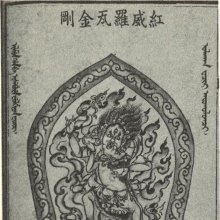Raktayamari, Raktayamāri, Rakta-yamari: 1 definition
Introduction:
Raktayamari means something in Buddhism, Pali. If you want to know the exact meaning, history, etymology or English translation of this term then check out the descriptions on this page. Add your comment or reference to a book if you want to contribute to this summary article.
Images (photo gallery)
In Buddhism
Tibetan Buddhism (Vajrayana or tantric Buddhism)
Source: archive.org: The Indian Buddhist Iconography1) Raktayamāri (रक्तयमारि) refers to one of the various emanations of Akṣobhya having their Sādhana described in the 5th-century Sādhanamālā (a collection of sādhana texts that contain detailed instructions for rituals).—His Colour is red; his Variety is yam-yum; he has two arms and one face.—When Yamāntaka is red he is called Raktayamāri and when he is blue he is called Kṛṣṇayamāri.—Six sādhanas are devoted to the worship of this variety of Yamāntaka. He is one-faced and two-armed and is embraced by the Prajñā who is his own creation.
The Dhyāna (meditation instructions) of Raktayamāri described in the Sādhanamālā as follows:—
“The worshipper should think himself as Yamāntaka, one-faced andtwo-armed, who stands in the pratyālīḍha attitude, carries the kapāla full of blood in the left hand and the white staff surmounted by a yellow head still wet with blood, in the right. He is decked in ornaments of snakes and his brown hair rises upwards. He wears garments of tiger-skin, bears the image of Akṣobhya on the crown, and is embraced by his Svābhā Prajñā. He stands on the orb of the sun over the double lotus on the back of a buffalo. He (the worshipper) should also meditate upon the Bhagavatī (Prajñā) who is one-faced, two-armed, and has variegated ornaments. She stands in the pratyālīḍha attitude, is intoxicated with wine, wears garments of tiger-skin which slips down her waist and remains in yab-yum with the god, both standing in the pratyālīḍha attitude. Thus meditating...”.
2) Raktayamāri (रक्तयमारि) also refers to one of the two forms of Yamāri or Yamāntaka: one of the ten deities of the quarters (Dikpāla) presiding over the east, commonly depicted in Buddhist Iconography, and mentioned in the 11th-century Niṣpannayogāvalī of Mahāpaṇḍita Abhayākara.—His Colour is blue; he has six arms and three faces.—Yamāntaka presides over the East and is one of the popular deities of the Buddhist pantheon He is also known as Yamāri who is often endowed with two forms known as Kṛṣṇa-Yamāri and Rakta-Yamāri.

Tibetan Buddhism includes schools such as Nyingma, Kadampa, Kagyu and Gelug. Their primary canon of literature is divided in two broad categories: The Kangyur, which consists of Buddha’s words, and the Tengyur, which includes commentaries from various sources. Esotericism and tantra techniques (vajrayāna) are collected indepently.
See also (Relevant definitions)
Partial matches: Yamari, Rakta.
Full-text: Yamantaka, Vajradanda, Yamari, Krishnayamari.
Relevant text
No search results for Raktayamari, Raktayamāri, Rakta-yamari, Rakta-yamāri; (plurals include: Raktayamaris, Raktayamāris, yamaris, yamāris) in any book or story.
Related products
